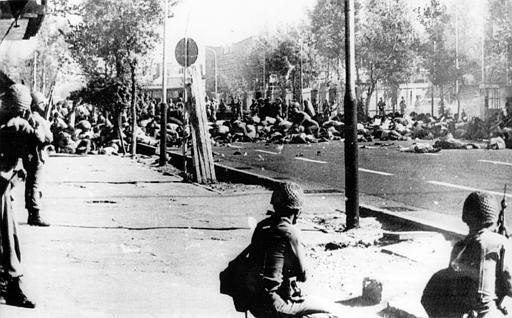Perpetrators Imperial Army of Iran | Deaths 88 | |
 | ||
Date 8 September 1978 (GMT+3.30) | ||
Black Friday (Persian: جمعه سیاه Jom'e-ye Siyāh) is the name given to 8 September 1978 (17 Shahrivar 1357 Iranian calendar) and the shootings in Jaleh Square (Persian: میدان ژاله Meydān-e Jāleh) in Tehran, Iran. The deaths and the reaction to them has been described as a pivotal event in the Iranian Revolution when any "hope for compromise" between the protest movement and the Shah's regime was extinguished.
Contents
Background and massacre
As protest against the Shah's rule continued during the spring and summer of 1978, the Iranian government declared martial law. On 8 September, thousands gathered in Tehran's Jaleh Square for a religious demonstration, despite the fact that the government had declared martial law the day before. The soldiers ordered the crowd to disperse, but the order was ignored. Initially, it was thought that either because of this reason, or because of the fact that the protesters kept pushing towards the military, the military opened fire, killing and wounding dozens of people.
Black Friday is thought to have marked the point of no return for the revolution, and led to the abolition of Iran's monarchy less than a year later. It is also believed that Black Friday played a crucial role in further radicalizing the protest movement, uniting the opposition to the Shah and mobilized the masses. Initially opposition and western journalists claimed that the Iranian army massacred thousands of protesters. The clerical leadership announced that "thousands have been massacred by Zionist troops."
The events triggered protests that continued for another four months. The day after Black Friday, 9 September 1978, Hoveyda resigned as minister of court, although unrelated to the situation. A general strike in October shut down the petroleum industry that was essential to the administration's survival, "sealing the Shah's fate". Continuation of protests ultimately led to Shah leaving from Iran in January 1979, clearing the way for the Iranian Revolution, led by the Ayatollah Khomeini.
Aftermath
Initially, western media and opposition incorrectly reported "15,000 dead and wounded", despite reports by the Iranian government officials that 86 people died in Tehran during the whole day. Michael Foucault, an influential French journalist and social theorist, first reported that 2000–3000 people died in the Jaleh Square and later he raised it to 4000 people dead. The BBC's correspondent in Iran, Andrew Whitley, reported that hundreds died.
According to Emad al-Din Baghi, a former researcher at the Martyrs Foundation (Bonyad Shahid, part of the current Iranian government, which compensates families of victims) hired "to make sense of the data" on those killed on Black Friday, 64 were killed in Jaleh Square on Black Friday, among them two females – one woman and a young girl. On the same day in other parts of the capital a total of 24 people died in clashes with martial law forces, among them one female, making the total casualties on the same day to 88 deaths. Another source puts the Martyrs Foundation tabulation of dead at 84 during that day.
The square's name was later changed to the Square of Martyrs (Maidan-e Shohada) by the Islamic republic.
Persian language
In 1978 shortly after the massacre, the Iranian musician Hossein Alizadeh set Siavash Kasraie's poem about the event to music. Mohammad Reza Shajarian sang the piece "Jāleh Khun Shod" (Jaleh [Square] became bloody).
English language
Nastaran Akhavan, one of the survivors, wrote the book Spared about the event. The book explains how the author was forced into a massive wave of thousands of angry protesters, who were later massacred by the Shah's military. The 2016 adventure video game 1979 Revolution: Black Friday is based on the event. The game is directed by Navid Khonsari, who was a child at the time of the revolution and admitted he did not have a realistic view of what was taking place. Khonsari described creating the game as "[wanting] people to feel the passion and the elation of being in the revolution – of feeling that you could possibly make a change."
